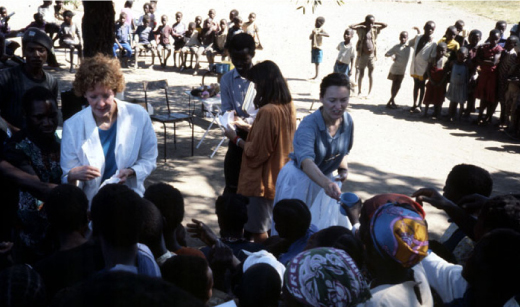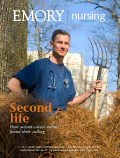Globetrotter: a public health nurse

For nurses considering careers outside the United States, a master's in public health nursing is the way to go, says assistant professor Linda Spencer.
Spencer, who has more than 20 years’ experience working around the world, says developing countries need nurses with expertise in working with populations as a whole, more so than knowledge of modern medical technology.
Spencer has worked in Zambia, India, Indonesia, Russia, and Iraq, among others, where she has developed a variety of training programs for nurses and other health care providers.
She shares her experiences and knowledge with students enrolled in the School of Nursing’s master’s in public health nursing program. It is the only such program in the state and one of only a few in the Southeast.
Spencer says her public health experience served her far better in those situations than her pharmaceutical or interventional knowledge.
“Many of the interventions we have available are not appropriate in a developing country,” she says. “These countries have limited access to drugs and don’t have the resources to replicate a medical intervention.”
|
In public health nursing, we look at the community as an aggregate, not as single patients. —Linda Spencer |
||||
A public health nursing degree, though, prepares nurses to assess populations and identify resources available to them.
“We’re much more focused on prevention than, for example, a nurse practitioner,” Spencer says. “In public health nursing, we look at the community as an aggregate, not as single patients. A community knows best what their problems are and how to best solve them. But they may not be able to articulate them, and that’s where we can be most effective.”
U.S.-based job opportunities in public health nursing have surged as companies and governments have focused on creating disaster-preparedness plans. Students gain experience while enrolled in the program by working in the community 500 hours over three semesters.
One such place was the Georgia Office of Preparedness, where public health nursing students reviewed pandemic flu plans for more than 100 counties last year. “They made recommendations to the plans that the department hadn’t thought of,” says Spencer. “Now the director wants to create a chief nurse position.”
“All nursing students take a community health course as undergraduates, and they learn there is a whole other world of nursing outside the hospital,” she says.
Recent articles from the School of NursingAmazon J., McNeely E., Lehr S., and Marquardt M., “The Decision-Making Process of Older Adults Who Elect to Receive ECT.” Journal of Psychosocial Nursing, 46[5], 2008. Hruschka D., Sibley L., Kalim N., Khan J., Paul M., Edmonds J., “When There is More Than One Answer Key: Cultural Theories of Postpartum Hemorrhage in Matlab, Bangladesh.” Field Methods, 2008; 20, 315-337. Sullivan A.M., Bauer-Wu S., Miovic M., “The Tong Ren Healing System: A Survey Study.” Complementary Health Practice Review; published online December 23, 2008 as doi:10.1177/1533210108329265. Murray, J.P. and Terrazas, S.B., “Solving the Shortage of Health Care Providers at the Grassroots Level: Ethiopia’s Response: The Carter Center Ethiopia Public Health Training Initiative.” In Hoyt, P., Fitzpatrick, J. & Smith, B., Problem Solving for Better Health: A Global Perspective, Springer Publishing Company, 2009. |
||||


